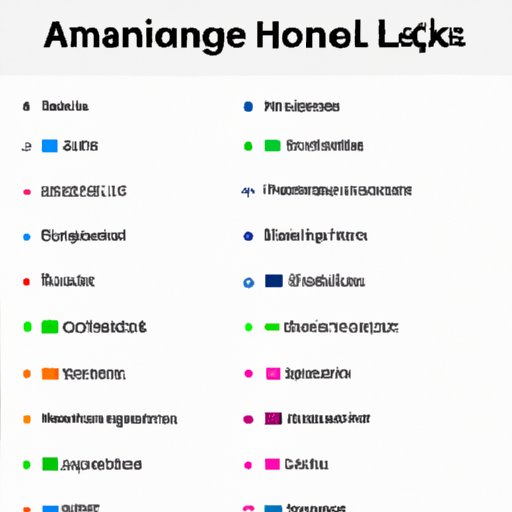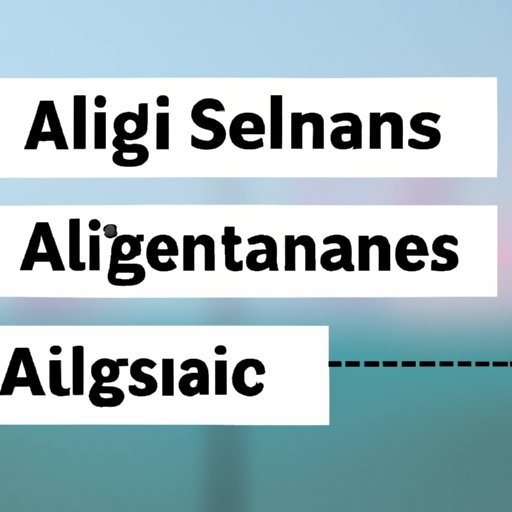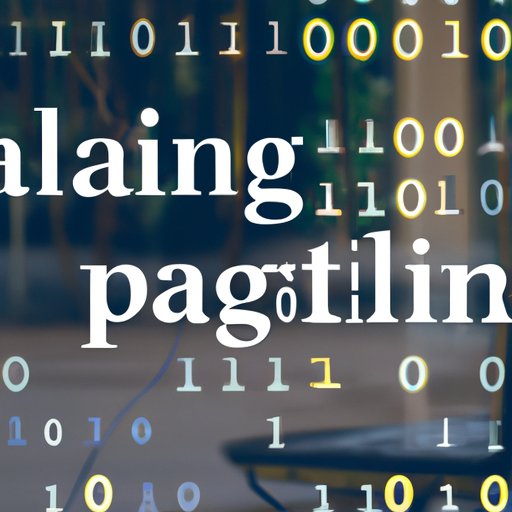Introduction
Artificial Intelligence (AI) is a rapidly evolving field of computer science that seeks to create intelligent machines capable of performing tasks that usually require human intelligence. As AI technologies become increasingly sophisticated and pervasive in our daily lives, it is important to understand the various programming languages used to develop these systems. In this article, we will explore the most commonly used programming languages for AI applications, their advantages and disadvantages, and provide a guide to help you choose the best language for your AI project.
A Comparison of Popular Programming Languages for AI Applications
When it comes to AI programming, there are a variety of languages available to choose from. Each has its own strengths and weaknesses, and understanding the differences between them can help you make an informed choice when selecting a language for your project. Here is a brief overview of some of the most popular programming languages for AI applications:
Python
Python is one of the most popular programming languages for AI development. It is a high-level, object-oriented language that provides developers with a wide range of features and libraries to help them create complex AI applications quickly and easily. Python’s simple syntax and readability make it easy to learn, while its powerful libraries and frameworks make it an excellent choice for developing AI projects.
Java
Java is another popular language for AI development. It is an object-oriented language that is designed to be platform-independent and secure, making it ideal for creating distributed AI applications. Additionally, Java’s extensive library of AI tools enables developers to create powerful AI applications with minimal effort.
C++
C++ is an object-oriented language that is widely used for AI development. It provides developers with a range of features and libraries that enable them to create complex AI applications quickly and efficiently. Additionally, C++ is relatively fast and can be used to create high-performance AI applications.
R
R is a statistical programming language that is popular for AI development. It provides developers with a wide range of tools and libraries for data analysis and visualization, making it an excellent choice for AI applications that involve large datasets. Additionally, R has a large user base and is supported by an active community of developers.
Lisp
Lisp is a functional programming language that is often used for AI development. Its powerful pattern-matching capabilities make it ideal for creating rule-based AI applications, while its flexible syntax makes it easy to learn and use. Additionally, Lisp’s garbage collection feature can help developers avoid memory leaks when working with large datasets.
Prolog
Prolog is a logic programming language that is often used for AI development. Its powerful inference engine enables developers to create complex AI applications quickly and easily, while its declarative syntax makes it easy to read and understand. Additionally, Prolog’s automated reasoning capabilities make it an excellent choice for AI projects that require sophisticated problem-solving capabilities.

An Overview of the Most Commonly Used Programming Languages for AI
The most commonly used programming languages for AI development are Python, Java, C++, R, Lisp, and Prolog. Python is a high-level, object-oriented language that provides developers with a wide range of features and libraries to help them create complex AI applications quickly and easily. Java is an object-oriented language that is designed to be platform-independent and secure, making it ideal for creating distributed AI applications. C++ is an object-oriented language that provides developers with a range of features and libraries that enable them to create complex AI applications quickly and efficiently. R is a statistical programming language that provides developers with a wide range of tools and libraries for data analysis and visualization. Lisp is a functional programming language that is often used for AI development due to its powerful pattern-matching capabilities. Finally, Prolog is a logic programming language that is often used for AI development due to its powerful inference engine and automated reasoning capabilities.
A Guide to Choosing the Right Programming Language for Your AI Project
Choosing the right programming language for your AI project can be challenging. There are a variety of factors to consider, such as your goals, skillset, and available resources. Here are some tips to help you make an informed decision:
Consider Your Goals
Before selecting a programming language for your AI project, it is important to consider your overall objectives. Different languages have different strengths and weaknesses, so it is important to choose a language that is well-suited to your specific goals. For example, if you are looking to create a distributed AI application, then Java would be a better choice than Python.
Analyze Your Skillset
In addition to considering your goals, it is important to analyze your existing skillset. Different languages require different levels of expertise, so it is important to select a language that you are comfortable working with. If you are a beginner, then Python might be a better choice than Java, as it is easier to learn.
Research the Available Resources
Finally, it is important to research the available resources before selecting a programming language for your AI project. Different languages have different levels of support and documentation, so it is important to choose a language that has a robust community of developers and plenty of online tutorials and guides.

The Benefits and Challenges of Using Programming Languages for AI
Using programming languages for AI development offers a number of benefits, including increased speed and efficiency, improved scalability, and greater flexibility. Additionally, programming languages offer developers access to a wide range of powerful tools and libraries, enabling them to create complex AI applications quickly and easily. However, there are also some challenges associated with using programming languages for AI development, such as the need for a thorough understanding of the language and the potential for errors and bugs.

An Introduction to the Different Types of AI Programming Languages
There are a variety of programming languages available for AI development, each of which is suited to different types of applications. Here is an overview of some of the most common types of AI programming languages:
Neural Networks
Neural networks are a type of AI programming language that is designed to replicate the behavior of neurons in the human brain. These networks are often used to model complex patterns and relationships, and are particularly useful for applications such as image and voice recognition. Popular neural network programming languages include TensorFlow and Caffe.
Natural Language Processing (NLP)
Natural language processing (NLP) is a type of AI programming language that is used to process and interpret human language. These languages are often used for applications such as machine translation, text summarization, and question answering. Popular NLP programming languages include Python, Java, and Prolog.
Machine Learning (ML)
Machine learning (ML) is a type of AI programming language that is used to create systems that can learn from data and improve over time. These languages are often used for applications such as facial recognition, object detection, and predictive analytics. Popular ML programming languages include Python, Java, and C++.
Robotics
Robotics is a type of AI programming language that is used to create autonomous robots. These languages are often used for applications such as navigation, manipulation, and task execution. Popular robotics programming languages include C++ and Python.
Conclusion
In conclusion, programming languages play an important role in AI development. Different languages have different strengths and weaknesses, so it is important to choose the right language for your project. Python, Java, C++, R, Lisp, and Prolog are some of the most popular programming languages for AI applications. Additionally, there are a variety of other languages available for specialized AI applications, such as neural networks, natural language processing, machine learning, and robotics. When selecting a language for your AI project, it is important to consider your goals, skillset, and available resources. By following these tips, you can ensure that you choose the best language for your project.
Summary
This article explored the different programming languages used for artificial intelligence (AI) applications. It compared popular languages such as Python, Java, C++, R, Lisp, and Prolog, offering a guide to choosing the right language for your project. It also examined the benefits and challenges of using programming languages for AI, as well as the different types of AI programming languages, such as neural networks, natural language processing, machine learning, and robotics.
Further Reading
For more information about programming languages for AI development, check out these resources:
- AI Programming Languages: An Overview
- What Is the Best Programming Language for AI Development?
-
(Note: Is this article not meeting your expectations? Do you have knowledge or insights to share? Unlock new opportunities and expand your reach by joining our authors team. Click Registration to join us and share your expertise with our readers.)
